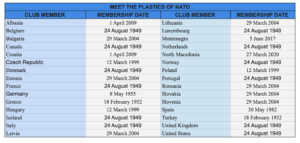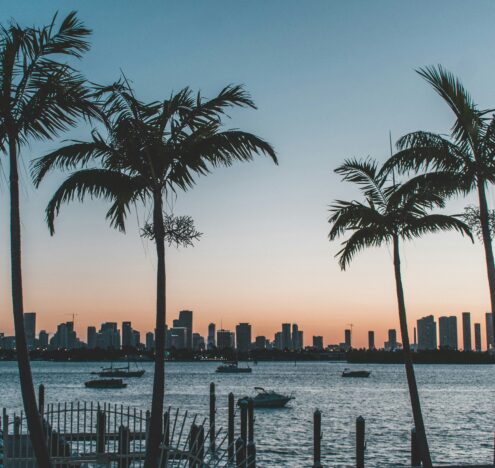BLUF: Tracing its roots back to 1947, perhaps the most well-known and effective alliance has been the political and military allegiance of the North Atlantic Treaty Organization (NATO). From peacekeeping following the Bosnia and Herzegovina war, to invoking Article 5 to defend the US following the 9/11 attacks, NATO has withstood the test of time. Its membership has expanded from 12 to 30 — and now Ukraine is knocking. Ukraine’s entry into the alliance, however, won’t come without challenge. Russia’s President Vladimir Putin sees Ukraine’s quest for NATO membership as a risk to his country’s own security and has positioned massive troops at the border in an effort to force the international community’s hand to fold. Will Washington come to Ukraine’s aid? The answer, as usual, is complicated.
The world is a lot like a high school. Different countries have different cliques and some of those cliques have seemingly more power than others — the cool kids if you will, like NATO. Some people are jealous of this clique, others hate it, and a few want to join it. But the dynamics of sitting at the “Plastics” table in Mean Girls are tricky and result from time to time in people jumping through hoops… not unlike joining one of the most powerful military and political alliances in the world.
These days, NATO has been making sure everyone is aware of how popular it is by keeping itself busy in the headlines amidst the bustle of Russian troops at the Ukrainian border. But before we inevitably get into that, let’s roll it back to the beginning to understand what NATO is, how it came to be, who sits at the table, and see if all that helps explain why Russia’s President Vladimir Putin has stationed troops at the Russia–Ukraine border.
NATO’s expansion into Ukraine, especially the deployment of any long-range missiles capable of striking Russian cities and missile defense systems, is seen as a direct security threat to Russia by Putin.
“ON WEDNESDAYS, WE WEAR PINK.”
Head to the land of NATO’s headquarters and you’ll find good beer, delicious waffles, and a powerful military alliance. NATO, the intergovernmental political and military alliance, sits in Brussels, Belgium. Drive an hour south and you’ll find the Supreme Headquarters Allied Powers Europe or SHAPE in the quaint town of Mons.
At its core, NATO is formed by independent countries that have agreed to the idea of “collective security.” You may have heard of NATO’s Article 5 (and unofficial slogan), “an attack on one is an attack on all.”
Voila: Collective security.
To be clear, that term suggests that if any external party attacks another member of NATO, the alliance’s response will be mounted by all.
Though mainly examined in a military light, NATO’s objectives are technically two-fold. The political objective is to promote democratic values and cooperate on defense and security-related issues to solve problems, build trust, and prevent conflict. The military objective is to commit to the peaceful resolution of disputes, but use collective military power to undertake if that fails.
NATO’s origins can be traced back to 1947 and the Treaty of Dunkirk by France and the United Kingdom to declare an alliance of mutual assistance should Germany or the Soviet Union attack after World War II. In 1948, the alliance expanded to include the three Benelux countries: Belgium, Netherlands, and Luxembourg. That crew became known as the Brussels Treaty Organization. In 1949, the military alliance known as the North Atlantic Treaty was signed to add the US, Canada, Portugal, Italy, Norway, Denmark, and Iceland.
In reality, that treaty didn’t do much until the Korean War, which is when the NATO of today really emerged. The US and NATO saw the Korean War as ultimately a Communist gateway, so in 1950, the NATO Military Committee called on its allied military forces to “counter potential Soviet and allied aggressions around the world.” It wasn’t long after, the organization formed SHAPE and appointed Dwight D. Eisenhower as its first leader. These efforts culminated in the February 1952 North Atlantic Council meeting in Lisbon to work through the logistics of operating NATO. A year later, the organization was up and running exercises — with Greece and Turkey added to the team.
“YOU CAN’T SIT WITH US!”
At its origins, NATO only had 12 members. Today, the alliance has 30 people eating at its lunchtime table. According to NATO’s website, alliance membership is open to “any other European state in a position to further the principles of this Treaty and to contribute to the security of the North Atlantic area.”
Interested in joining? For only $99.99 a year! Just kidding.
NATO uses a Membership Action Plan (MAP) to help “aspiring members” achieve membership by meeting “key requirements” and “by providing practical advice and targeted assistance.” The MAP process for NATO accession — or guide to becoming a member if you will — was launched in 1999 and has helped 11 countries (Albania, Bulgaria, Croatia, Estonia, Latvia, Lithuania, Montenegro, the Republic of North Macedonia, Romania, Slovakia, and Slovenia) join the alliance since.
The MAP process can only start by official invitation, and currently, Bosnia and Herzegovina is the only ongoing country participating, having been invited in 2010. Both Georgia and Ukraine, however, have clearly shown their desire to join as well, which has been met with varying support amongst member states (peep the NATO/Russia/Ukraine elephant in the room). This is different from Individual Partnership Action Plans (IPAPs) that outline objectives and frameworks for dialogue and cooperation between NATO and a given country. NATO launched the IPAPs initiative at the 2002 Prague Summit. At the moment, Georgia, Azerbaijan, Armenia, Kazakhstan, and Moldova all have them. An IPAP, however, does not guarantee NATO membership.
“I WISH WE COULD ALL GET ALONG LIKE WE USED TO IN MIDDLE SCHOOL”
NATO has had a few pivotal moments in international events over the years. The first was in 1995 when it decided to engage with the Bosnia and Herzegovina crisis. The NATO operation focused on peacekeeping by deploying its Implementation Force in December 1995 to oversee the military aspect implementation of the Dayton Peace Agreement. It was replaced in 1996 by the NATO-led Stabilization Force, which helped to keep the peace and facilitate the country’s reconstruction in the wake of the country’s 1992–1995 war.
In 2001, after the terror attacks launched against the US in New York and Washington, DC, NATO invoked its Article 5 for the first time:
The Parties agree that an armed attack against one or more of them in Europe or North America shall be considered an attack against them all and consequently, they agree that, if such an armed attack occurs, each of them, in exercise of the right of individual or collective self-defense recognized by Article 51 of the Charter of the United Nations, will assist the Party or Parties so attacked by taking forthwith, individually and in concert with the other Parties, such action as it deems necessary, including the use of armed force, to restore and maintain the security of the North Atlantic area.
Any such armed attack and all measures taken as a result thereof shall immediately be reported to the Security Council. Such measures shall be terminated when the Security Council has taken the measures necessary to restore and maintain international peace and security.
And in 2003, at the mandate of the UN, NATO took command of the International Security Assistance Force in Afghanistan to create the conditions for the Afghan government to exercise its own authority throughout the country and build the capacity of the Afghan forces to fight international terrorism. The operation officially ended in December 2014 when the Afghan National Defense and Security Forces assumed full responsibility for its own forces, but NATO remained in Afghanistan to train, advise, and assist. Though (as you likely remember the quasi-sh*t show that occurred last year) an agreement was signed with the Taliban to remove all international troops from the country. Therefore, in April 2021, NATO Foreign and Defense ministers decided to withdraw all Allied troops from Afghanistan, and NATO effectively suspended all areas of cooperation with Afghanistan.
“STOP TRYING TO MAKE ‘FETCH’ HAPPEN!”
So, what does all of this have to do with today’s tensions at the Russia–Ukraine border? Well…everything.
Ukraine has had NATO ambitions for years and part of the “Euromaidan” protests of 2014 leading to the removal of the then pro-Russian President Viktor Yanukovych was fueled by his decision to suspend all efforts of European integration, including the signing of the country’s partnership with the European Union and its IPAP with NATO. Eventually, back on course, the Ukrainian Constitution was amended in 2019 to reflect its intent for membership with the EU and NATO. In the summer of 2021, at the Brussels Summit, NATO leaders reiterated a prior decision from 2008 that Ukraine would become a member of the alliance with the MAP. Naturally, Putin was less than pleased.
Despite the peace being kept between NATO countries, the debate of what comes next with Russia and NATO is really rooted in the Korean War part of the organization’s history.
Putin has whistled the same tune on NATO expansion for a while: NATO’s expansion into Ukraine, especially the deployment of any long-range missiles capable of striking Russian cities and missile defense systems similar to those in Romania and Poland, is seen as a direct security threat to Mother Russia by Putin. He said any such action would be a “red line” issue for him and the country. To be fair, Putin is not being delusional. After all, one of the reasons why NATO was created to counter Soviet Union, and now Russian, advances. So, in December 2021, Putin then asked President Joe Biden for some legal guarantees that NATO wouldn’t expand eastward (AKA into Ukraine) or put “weapons systems that threaten us in close vicinity to Russian territory.” NATO has been firm in its commitment to continue Ukraine’s alliance pursuit with NATO Secretary-General Jens Stoltenberg replying:
“It’s only Ukraine and 30 NATO allies that decide when Ukraine is ready to join NATO. Russia has no veto, Russia has no say, and Russia has no right to establish a sphere of influence to try to control their neighbors.”
Ultimately, as a member of NATO and promoter of democracy, the US is supporting its European allies to counter Russia at the Ukrainian border with massive troop counts, exercises, and verbal threats — and ultimately defending Ukraine’s right to pursue NATO membership. Last week, US Secretary of Defense Lloyd Austin put 8,500 troops on “heightened alert” to support NATO if necessary, and sent military equipment and munitions to assist. The Biden administration is also considering sanctions against Russia and its president.
“EX-BOYFRIENDS ARE OFF-LIMITS TO FRIENDS. THAT’S JUST, LIKE, THE RULES OF FEMINISM.”
Despite the serious and mounting pressure from Russia, NATO allyship has not just helped maintain the peace and security of its own member countries over its lifetime but has also helped create security for the additional 20 countries that participate in NATO’s Partnership for Peace and 15 other countries involved in institutionalized NATO programs. Some concerns over financial contributions by certain member states (*cough* the US *cough*) arose under the Trump administration but members have since agreed to reach or maintain spending contributions of at least 2% of their GDP by 2024.
Despite the peace being kept between NATO countries, the debate of what comes next with Russia and NATO is really rooted in the Korean War part of the organization’s history. The question of whether or not NATO should continue to represent Western interests militarily and politically by expanding East to counter Russia’s military and political interests in Europe? Putin believes NATO’s eastward encroachment with Ukrainian membership is a broken promise. “You promised us in the 1990s that [NATO] would not move an inch to the East. You cheated us shamelessly,” Putin said at a news conference in December. But, of course, America says that expansion bans were never a thing. The classic he said, he said. So, what does NATO do now?
Option 1: Give Ukraine the outfit schedule, they’re in!
The first option for NATO is to go ahead and prepare seriously for Ukraine’s full membership. This would include setting a timeline and booking a date for ascension. Ukraine has been doing the work and NATO has already strengthened its relationship with the country by making it an “Enhanced Opportunities Partner” or EOP. The EOP program within NATO aims “to support and deepen cooperation between allies and partners, which have made significant contributions to NATO-led operations and missions.” Ukraine joins Sweden, Finland, Australia, and Jordan in this specific category. This option seems unlikely given that Biden, US Secretary of State Antony Blinken, and NATO have all either downplayed or remained silent on the issue of setting a sure timeline for membership. If and when Ukraine becomes a full NATO member, any conflict with Russia would likely invoke Article 5, causing the West (read: America) to back war with one of our longtime adversaries — and a superpower.
Option 2: Burn Book ‘em, they’re out!
It is possible for NATO to recognize that serious consideration of Ukrainian NATO membership is destabilizing for global peace. After all, who wants to go to war with Russia and ignite a massive geopolitical conflict? If NATO decides to take Russian threats seriously to invade Ukraine either now because of the possibility of NATO expansion or later after a membership is complete, the organization might decide to scrap the whole thing altogether. This seems like the most unlikely of scenarios. It behooves the international community to have strong relations with Ukraine given its location on the map strategically and its strong desire to improve democracy in Europe. Ukraine, who also has a vested interest in the West, will keep jumping through NATO’s hoops with the hope to one day join the cool kids at the table, but I don’t see NATO throwing Ukraine into the book just to let them burn.
Option 3: Be cordial in the hallways only.
NATO can remain committed to Ukraine’s security by showing up with military support, publicly acknowledging the strong relationship with the country, and reassuring external audiences of its commitment to Ukraine’s pathway to alliance membership all while knowing that commitment is largely one of symbolism to protect the Ukraine from external invasion. This seems like the most likely prospect for the NATO/Ukrainian relationship for the foreseeable future. It allows the US to save face and support Ukraine militarily without actually having to go to legit war with Russia. And realistically, without a solid timeline commitment from the US, it’s unlikely the country is going to get backing from any other NATO country on the subject either.
Whether or not Ukraine will get to wear pink at the end of the day remains to be seen. But the international community, specifically NATO members and partners, has promised it will do everything in its power to get them there if it remains the interest of the country to join. Russia may receive some successions from the West along the way but for now the line is holding steady.
That’s all for this one, babes.
No pressure. No bullshit. Just, THE BABES BLUF.
THE BABES BLUF (bottom line up front) is a different kind of current affairs and lifestyle blog that talks about issues in a way women (and men!) can relate to and enjoy. To read more from THE BABES BLUF, visit www.thebabesbluf.com and subscribe to never miss a #BLUF, and check them out on Twitter or Instagram. For more THE BABES BLUF pieces, see here.






















